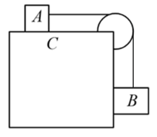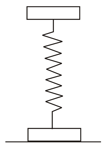Embibe Experts Solutions for Chapter: Elasticity, Exercise 2: Exercise - 2
Embibe Experts Physics Solutions for Exercise - Embibe Experts Solutions for Chapter: Elasticity, Exercise 2: Exercise - 2
Attempt the free practice questions on Chapter 12: Elasticity, Exercise 2: Exercise - 2 with hints and solutions to strengthen your understanding. Alpha Question Bank for Engineering: Physics solutions are prepared by Experienced Embibe Experts.
Questions from Embibe Experts Solutions for Chapter: Elasticity, Exercise 2: Exercise - 2 with Hints & Solutions
The compressibility of water is . This means that
If the ratio of lengths, radii and Young’s moduli of steel and brass wires in the figure are and respectively. Then the corresponding ratio of increase in their lengths would be:

If a rubber ball is taken at the depth of in a pool, its volume decreases by . If the density of the water is and , then the volume elasticity in will be
A rod long is in the area for a portion of its length and in the area for the remaining. The strain energy of this stepped bar is of that a bar in the area and long under the same maximum stress. What is the length of the portion in area?
Two block and are connected to each other by a string, passing over a frictionless pulley as shown in the figure. Block slides over the horizontal top surface of a stationary block and block slide along the vertical side of both with uniform speed. The coefficient of friction between the surface of blocks is . String stiffness is . If mass of block is . Calculate ratio (in ) of the mass of block and the energy stored in the string.

The wires and shown in the figure, are made of the same material and have radii and . A block of mass is tied between them. If the force is , one of the wires breaks.

A metal wire of length area of cross-section and young's modulus is stretched by a variable force such that is always slightly greater than the elastic forces of resistance in the wire. When the elongation of the wire is
Two plates of the same mass are attached rigidly to the two ends of a spring as shown in the figure. One of the plates rests on a horizontal surface and the other results a compression of the spring when it is in an equilibrium state. The further minimum compression required, so that after the force causing compression is removed the lower plate is lifted off the surface, will be,

